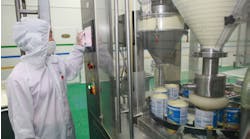Did your mother hound you about cleaning up after yourself or constantly scold you for not putting away stuff after you used it? Many plants also deserve these rebukes. Most facilities I visit certainly do. I may see a sledge hammer stuffed away in a corner, large barrels in odd locations or unusual welding on pipes. These aren’t safety issues per se but could be if left unchecked. The hammer usually is near a discharge chute or an undersized pipe and is used to get solids to flow. The barrels frequently are needed for housekeeping after a recurring pluggage, so taking them away seems a waste of time.
[pullquote]
While inspecting a new process layout with a colleague, I asked him if one of the chutes was adequate for the product. He replied he thought it was okay because there was room enough to get a rod into it. This wasn’t the answer I had hoped for. However, it underscores that the flowability of particulate solids usually doesn’t get suitable attention.
Flowability testing is expensive and often neglected during process development. Even when conducted, such tests only cover a narrow range of environmental conditions and consolidations. So, a subsequent change in particle specifications may require retesting.
One of our plants had sent a new product out for shear-cell testing so we could properly design chutes and storage vessels. During process development, our customers preferred a slightly different particle size. Had they liked a smaller size, we might have had to repeat some of the testing. However, they favored a slightly larger size; this was fortunate because, as I explained, the larger particles weren’t a problem for flow. We just needed to be more aware of segregation.
This experience points up how poorly solids flow is understood. The shear-cell testing was conducted with screened material because the larger particles don’t reduce flowability. The plant was prepared to retest the material just because of the change to the larger size.
Abrasion seldom is noticed until a pipeline starts to leak. I’ve seen many plants address this situation by welding a plate over the hole. It’s a temporary fix that’s often repeated until the leak stops (or the patch becomes excessively large). It’s interesting to note that patched pneumatic conveyor lines that eventually stop leaking also have lower pressure drops. In studies of elbow configurations, we’ve seen that T-bend elbows perform better than long-radius elbows. The patching of an elbow seems to give a similar flow pattern for the solids, so the result isn’t surprising. While this isn’t flowability in the strictest interpretation, it results in better flow and less shear stress on the pipe.
Plant managers don’t always see solids handling operations as influencing the bottom line until something big shows up on the balance sheet. We shipped an intermediate powder product by bulk bag from one plant to another several hundred miles away. During transport, the fines agglomerated due to several factors (vibration, stacking the bags too high and a weak particle structure). When the bag arrived at the other plant, most of its content was a solid block. Previous tests on shipping the product used 50-lb bags, so this was a surprise. To make the product suitable for handling, the plant repeatedly backed a forklift truck into the bag. This worked quite well but took a toll on the forklift. When two requisitions for new forklift trucks appeared in less than three months, management began asking questions. It was cheaper to ship 50-lb bags than continue to buy forklift trucks. The company could have avoided this entire situation by obtaining flowability data on the product at various consolidation conditions. Eventually, it discontinued shipping this intermediate product and moved all operations to one plant.
So, even though obtaining flowability data can be expensive, I encourage designers and plant operators to obtain such data, especially for a new product. Also, operators shouldn’t accept layouts that likely will require banging on an elbow or chute — or product handling that may involve using a forklift truck as a battering ram. It’s time we remembered our mother’s scolding and cleaned up our act.



